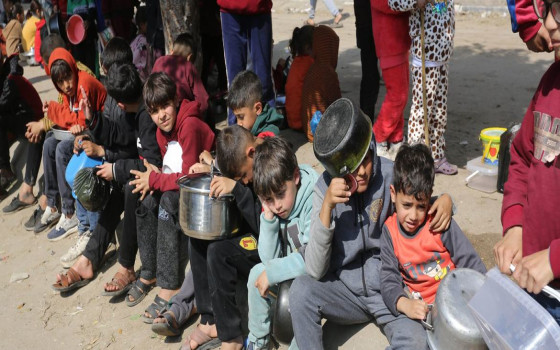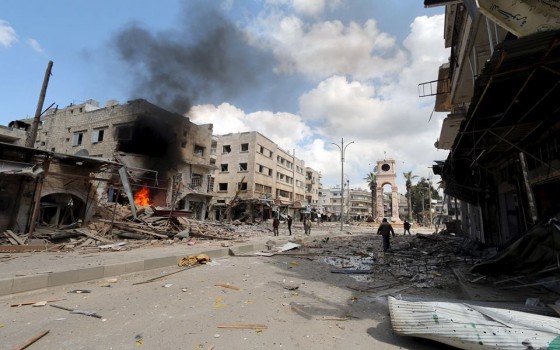
UN report: Famine threatens 22 countries and regions, especially conflict zones, including Gaza and Sudan

- Europe and Arabs
- Friday , 1 November 2024 7:28 AM GMT
Capitals: Europe and the Arabs
Acute food insecurity is expected to increase in size and severity in 22 countries and territories, according to a new UN report that warns that the spread of conflicts, particularly in the Middle East, along with climate and economic pressures, are pushing millions of people to the brink. According to the UN daily news bulletin, a copy of which we received this Friday morning.
The report sheds light on the regional repercussions of the crisis in Gaza, and warns that the La Niña weather pattern could affect the climate until March 2025, threatening fragile food systems in areas already suffering from fragility.
The report was issued yesterday, Thursday, jointly by the Food and Agriculture Organization (FAO) and the World Food Programme, and was titled: "Hunger Hotspots - Early Warnings by FAO and WFP on Acute Food Insecurity".
Darfur and Gaza
The report draws attention to the famine in Zamzam camp in North Darfur and the risk of famine in other parts of Sudan, the continuing risk of famine in Palestine (Gaza Strip), and the catastrophic levels of acute food insecurity in Haiti, Mali and South Sudan.
It warns that without immediate humanitarian action and concerted efforts to overcome severe access constraints and resolve ongoing conflicts, further famine and death are likely.
Urgent humanitarian action is needed to save lives and livelihoods and prevent famine and death in hotspots where there is a high risk of worsening acute hunger between November 2024 and May 2025.
In total, 22 countries/territories are classified as “hunger hotspots”, where levels of acute food insecurity are expected to deteriorate further due to a combination of conflict, economic instability and climate shocks over the forecast period. Without immediate intervention, including increased funding for food and livelihood assistance, hundreds of thousands of people are expected to face famine in the coming months, according to the report.
Peace is a prerequisite for food security
“The situation is catastrophic in the five most alarming hunger hotspots. People are severely food insecure and facing an unprecedented level of persistent famine fueled by escalating conflicts, climate crises and economic shocks. If we are to save lives and prevent acute hunger and malnutrition, we urgently need a humanitarian ceasefire, and restore access to and availability of highly nutritious food, including by revitalizing local food production,” said FAO Director-General Qu Dongyu.
But this alone is not enough, he said: “We need long-term stability and food security. Peace is a prerequisite for food security. Without peace and stability, farmers cannot grow or harvest food or sustain their livelihoods. Access to nutritious food is not just a basic need – it is a fundamental human right.”
Diplomatic solutions to conflicts
“Around the world, conflicts are escalating, economic instability is increasing, and climate disasters are becoming the new normal. With more effective political and financial support, humanitarians can implement proven, scalable solutions to address hunger and reduce needs in the long term,” said Cindy McCain, Executive Director of the World Food Programme.
“It is time for world leaders to step up and work with us to reach the millions of people at risk of famine – by offering diplomatic solutions to conflicts, using their influence to enable humanitarians to work safely, and mobilizing the resources and partnerships needed to stop global hunger.”
Key findings of the report
According to the report, Palestine, Sudan, South Sudan, Haiti and Mali remain at the highest level of alert and require urgent attention. Conflict is the primary driver of hunger in all of these regions. All of the communities in the most alarming hotspots are already facing, or are at risk of, famine, or are facing catastrophic conditions of acute food insecurity.
Chad, Lebanon, Myanmar, Mozambique, Nigeria, Syria and Yemen are hotspots of grave concern, with large numbers of people facing acute food insecurity, with worsening factors expected to exacerbate life-threatening conditions in the coming months. Since the previous edition of the Hunger Hotspots report (June 2024), Kenya, Lesotho, Namibia and Niger have joined the list of hunger hotspots, along with Burkina Faso, Ethiopia, Malawi, Somalia, Zambia and Zimbabwe, where acute food insecurity is likely to deteriorate further over the forecast period.












No Comments Found